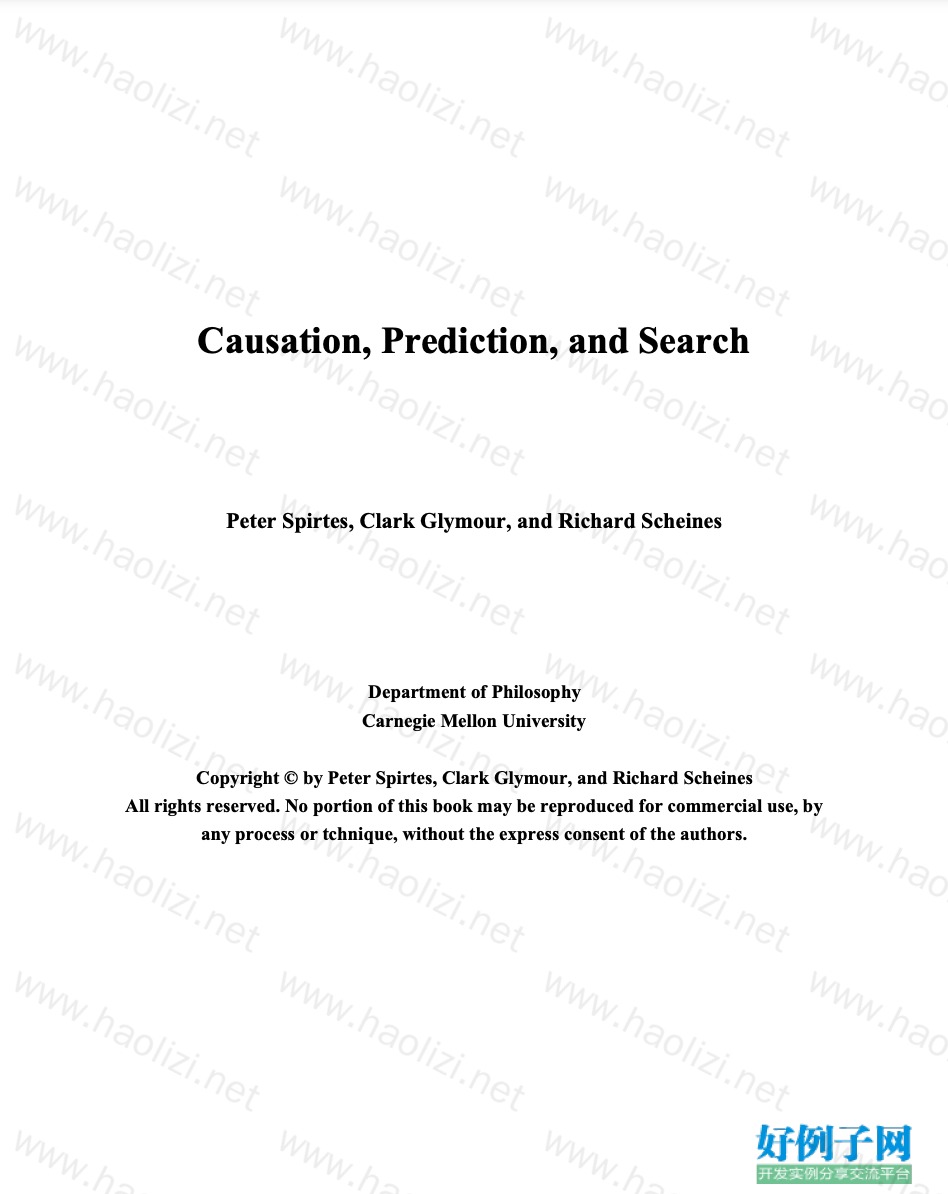实例介绍
【实例截图】

【核心代码】
Table of Contents Preface ................................................................................................................................vii Acknowledgments..............................................................................................................xiii Notational Conventions.....................................................................................................xxi 1. Introduction and Advertisement ..................................................................................1 1.1 The Issue............................................................................................................1 1.2 Advertisements ..................................................................................................10 1.2.1 Bayes Networks from the Data...........................................................11 1.2.2 Structural Equation Models from the Data.........................................13 1.2.3 Selection of Regressors.......................................................................14 1.2.4 Causal Inference without Experiment ................................................17 1.2.5 The Structure of the Unobserved........................................................19 1.3 Themes...............................................................................................................21 2. Formal Preliminaries.....................................................................................................25 2.1 Graphs................................................................................................................25 2.2 Probability..........................................................................................................31 2.3 Graphs and Probability Distributions ................................................................32 2.3.1 Directed Acyclic Graphs.....................................................................32 2.3.2 Directed Independence Graphs...........................................................34 2.3.3 Faithfulness.........................................................................................35 2.3.4 d-separation.........................................................................................36 2.3.5 Linear Structures.................................................................................36 2.4 Undirected Independence Graphs......................................................................37 2.5 Deterministic and Pseudo-Indeterministic Systems ..........................................38 2.6 Background Notes .............................................................................................39 3. Causation and Prediction: Axioms and Explications.................................................41 3.1 Conditionals.......................................................................................................41 3.2 Causation ...........................................................................................................42 3.2.1 Direct vs. Indirect Causation ..............................................................42 3.2.2 Events and Variables ..........................................................................43 3.2.3 Examples.............................................................................................45 3.2.4 Representing Causal Relations with Directed Graphs........................47 3.3 Causality and Probability...................................................................................49 3.3.1 Deterministic Causal Structures .........................................................49 3.3.2 Pseudo-Indeterministic and Indeterministic Causal Structures ..........51 3.4 The Axioms .......................................................................................................53 3.4.1 The Causal Markov Condition............................................................53 3.4.2 The Causal Minimality Condition ......................................................55 3.4.3 The Faithfulness Condition.................................................................56 3.5 Discussion of the Conditions.............................................................................57 3.5.1 The Causal Markov and Minimality Conditions ................................57 3.5.2 Faithfulness and Simpson's Paradox...................................................64 3.6 Bayesian Interpretations ....................................................................................70 3.7 Consequences of The Axioms ...........................................................................71 3.7.1 d-Separation........................................................................................71 3.7.2 The Manipulation Theorem ................................................................75 3.8 Determinism ......................................................................................................81 3.9 Background Notes .............................................................................................86 4. Statistical Indistinguishability ......................................................................................87 4.1 Strong Statistical Indistinguishability................................................................88 4.2 Faithful Indistinguishability...............................................................................89 4.3 Weak Statistical Indistinguishability .................................................................90 4.4 Rigid Indistinguishability ..................................................................................93 4.5 The Linear Case.................................................................................................94 4.6 Redefining Variables .........................................................................................99 4.7 Background Notes .............................................................................................101 5. Discovery Algorithms for Causally Sufficient Structures..........................................103 5.1 Discovery Problems...........................................................................................103 5.2 Search Strategies in Statistics ............................................................................104 5.2.1 The Wrong Hypothesis Space ............................................................105 5.2.2 Computational and Statistical Limitations..........................................107 5.2.3 Generating a Single Hypothesis..........................................................108 5.2.4 Other Approaches ...............................................................................109 5.2.5 Bayesian Methods...............................................................................109 5.3 The Wermuth-Lauritzen Algorithm...................................................................111 5.4 New Algorithms.................................................................................................112 5.4.1 The SGS Algorithm ............................................................................114 5.4.2 The PC Algorithm...............................................................................116 5.4.3 The IG (Independence Graph) Algorithm ..........................................124 5.4.4 Variable Selection...............................................................................125 5.4.5 Incorporating Background Knowledge...............................................127 5.5 Statistical Decisions...........................................................................................128 5.6 Reliability and Probabilities of Error.................................................................130 5.7 Estimation ..........................................................................................................132 5.8 Examples and Applications ...............................................................................132 5.8.1 The Causes of Publishing Productivity...............................................133 5.8.2 Education and Fertility .......................................................................139 5.8.3 The Female Orgasm............................................................................140 5.8.4 The American Occupational Structure ...............................................142 5.8.5 The ALARM Network........................................................................145 5.8.6 Virginity..............................................................................................147 5.8.7 The Leading Crowd ............................................................................147 5.8.8 Influences on College Plans................................................................149 5.8.9 Abortion Opinions ..............................................................................150 5.8.10 Simulation Tests with Random Graphs...........................................152 5.9 Conclusion .........................................................................................................161 5.10 Background Notes ...........................................................................................162 6. Discovery Algorithms without Causal Sufficiency .....................................................163 6.1 Introduction........................................................................................................163 6.2 The PC Algorithm and Latent Variables ...........................................................165 6.3 Mistakes.............................................................................................................168 6.4 Inducing Paths ...................................................................................................173 6.5 Inducing Path Graphs ........................................................................................174 6.6 Partially Oriented Inducing Path Graphs...........................................................177 6.7 Algorithms for Causal Inference with Latent Common Causes........................181 6.8 Theorems on Detectable Causal Influence ........................................................190 6.9 Non-Independence Constraints..........................................................................191 6.10 Generalized Statistical Indistinguishability and Linearity...............................193 6.11 The Tetrad Representation Theorem ...............................................................196 6.12 An Example: Math Marks and Causal Interpretation ......................................197 6.13 Background Notes ...........................................................................................200 7. Prediction........................................................................................................................201 7.1 Introduction........................................................................................................201 7.2 Prediction Problems...........................................................................................202 7.3 Rubin-Holland-Pratt-Schlaifer Theory ..............................................................203 7.4 Prediction with Causal Sufficiency ...................................................................213 7.5 Prediction without Causal Sufficiency ..............................................................216 7.6 Examples............................................................................................................227 7.7 Conclusion .........................................................................................................237 7.8 Background Notes ............................................................................................237 8. Regression, Causation and Prediction .........................................................................238 8.1 When Regression Fails to Measure Influence ...................................................238 8.2 A Solution and Its Application ..........................................................................242 8.2.1 Components of the Armed Forces Qualification Test ........................243 8.2.2 The Causes of Spartina Biomass ........................................................244 8.2.3 The Effects of Foreign Investment on Political Repression ...............248 8.2.4 More Simulation Studies ....................................................................250 8.3 Error Probabilities for Specification Searches...................................................252 8.4 Conclusion .........................................................................................................257 9. The Design of Empirical Studies ..................................................................................259 9.1 Observational or Experimental Study?..............................................................259 9.2 Selecting Variables ............................................................................................271 9.3 Sampling ............................................................................................................272 9.4 Ethical Issues in Experimental Design ..............................................................276 9.4.1 The Kadane/Sedransk/Seidenfeld Design...........................................277 9.4.2 Causal Reasoning in the Experimental Design...................................280 9.4.3 Towards Ethical Trials........................................................................286 9.5 An Example: Smoking and Lung Cancer ..........................................................291 9.6 Appendix............................................................................................................302 10. The Structure of the Unobserved ...............................................................................306 10.1 Introduction......................................................................................................306 10.2 An Outline of the Algorithm............................................................................307 10.3 Finding Almost Pure Measurement Models....................................................310 10.3.1 Intra-Construct Foursomes ...............................................................310 10.3.2 Cross-Construct Foursomes..............................................................311 10.4 Facts about the Unobserved Determined by the Observed..............................315 10.5 Unifying the Pieces..........................................................................................316 10.6 Simulation Tests ..............................................................................................320 10.7 Conclusion .......................................................................................................322 11. Elaborating Linear Theories with Unmeasured Variables......................................323 11.1 Introduction......................................................................................................323 11.2. The Procedure.................................................................................................324 11.2.1 Scoring..............................................................................................324 11.2.2 Search ...............................................................................................327 11.3. The LISREL and EQS Procedures .................................................................329 11.3.1 Input and Output ...............................................................................329 11.3.2 Scoring..............................................................................................330 11.3.3 The LISREL VI Search ....................................................................331 11.3.4 The EQS Search................................................................................331 11.4. The Primary Study..........................................................................................332 11.4.1 The Design of Comparative Simulation Studies ..............................332 11.4.2 Study Design.....................................................................................333 11.5 Results..............................................................................................................343 11.6 Reliability and Informativeness.......................................................................346 11.7 Using LISREL and EQS as Adjuncts to Search ..............................................349 11.8 Limitations of the TETRAD II Elaboration Search.........................................351 11.9 Some Morals for Statistical Search..................................................................352 12. Open Problems.............................................................................................................354 12.1 Feedback, Reciprocal Causation, and Cyclic Graphs......................................354 12.1.1 Mason's Theorem..............................................................................355 12.1.2 Time Series and Cyclic Graphs ........................................................356 12.1.3 The Markov Condition, Factorizability and Faithfulness.................359 12.1.4 Discovery Procedures .......................................................................360 12.2 Indistinguishability Relations..........................................................................361 12.3 Time series and Granger Causality..................................................................363 12.4 Model Specification and Parameter Estimation from the Same Data Base.....365 12.5 Conditional Independence Tests......................................................................366 13. Proofs of Theorems......................................................................................................367 13.1 Theorem 2.1.....................................................................................................367 13.2 Theorem 3.1.....................................................................................................367 13.3 Theorem 3.2.....................................................................................................374 13.4 Theorem 3.3.....................................................................................................376 13.5 Theorem 3.4.....................................................................................................385 13.6 Theorem 3.5.....................................................................................................386 13.7 Theorem 3.6 (Manipulation Theorem) ............................................................395 13.8 Theorem 3.7.....................................................................................................398 13.9 Theorem 4.1.....................................................................................................401 13.10 Theorem 4.2...................................................................................................403 13.11 Theorem 4.3...................................................................................................403 13.12 Theorem 4.4...................................................................................................404 13.13 Theorem 4.5...................................................................................................404 13.14 Theorem 4.6...................................................................................................405 13.15 Theorem 5.1...................................................................................................405 13.16 Theorem 6.1...................................................................................................408 13.17 Theorem 6.2...................................................................................................411 13.18 Theorem 6.3...................................................................................................414 13.19 Theorem 6.4...................................................................................................417 13.20 Theorem 6.5...................................................................................................418 13.21 Theorem 6.6...................................................................................................419 13.22 Theorem 6.7...................................................................................................424 13.23 Theorem 6.8...................................................................................................425 13.24 Theorem 6.9...................................................................................................425 13.25 Theorem 6.10 (Tetrad Representation Theorem) ..........................................426 13.26 Theorem 6.11.................................................................................................460 13.27 Theorem 7.1...................................................................................................460 13.28 Theorem 7.2...................................................................................................462 13.29 Theorem 7.3...................................................................................................463 13.30 Theorem 7.4...................................................................................................470 13.31 Theorem 7.5...................................................................................................471 13.32 Theorem 9.1...................................................................................................472 13.33 Theorem 9.2...................................................................................................472 13.34 Theorem 10.1.................................................................................................473 13.35 Theorem 10.2.................................................................................................476 13.36 Theorem 11.1.................................................................................................479 Glossary ..............................................................................................................................481 Bibliography.......................................................................................................................495 Index....................................................................................................................................517
标签: Causation Prediction
相关软件
小贴士
感谢您为本站写下的评论,您的评论对其它用户来说具有重要的参考价值,所以请认真填写。
- 类似“顶”、“沙发”之类没有营养的文字,对勤劳贡献的楼主来说是令人沮丧的反馈信息。
- 相信您也不想看到一排文字/表情墙,所以请不要反馈意义不大的重复字符,也请尽量不要纯表情的回复。
- 提问之前请再仔细看一遍楼主的说明,或许是您遗漏了。
- 请勿到处挖坑绊人、招贴广告。既占空间让人厌烦,又没人会搭理,于人于己都无利。
关于好例子网
本站旨在为广大IT学习爱好者提供一个非营利性互相学习交流分享平台。本站所有资源都可以被免费获取学习研究。本站资源来自网友分享,对搜索内容的合法性不具有预见性、识别性、控制性,仅供学习研究,请务必在下载后24小时内给予删除,不得用于其他任何用途,否则后果自负。基于互联网的特殊性,平台无法对用户传输的作品、信息、内容的权属或合法性、安全性、合规性、真实性、科学性、完整权、有效性等进行实质审查;无论平台是否已进行审查,用户均应自行承担因其传输的作品、信息、内容而可能或已经产生的侵权或权属纠纷等法律责任。本站所有资源不代表本站的观点或立场,基于网友分享,根据中国法律《信息网络传播权保护条例》第二十二与二十三条之规定,若资源存在侵权或相关问题请联系本站客服人员,点此联系我们。关于更多版权及免责申明参见 版权及免责申明



网友评论
我要评论